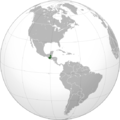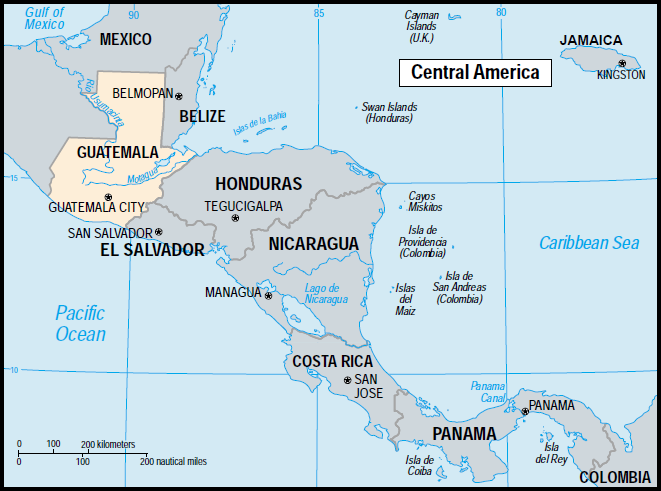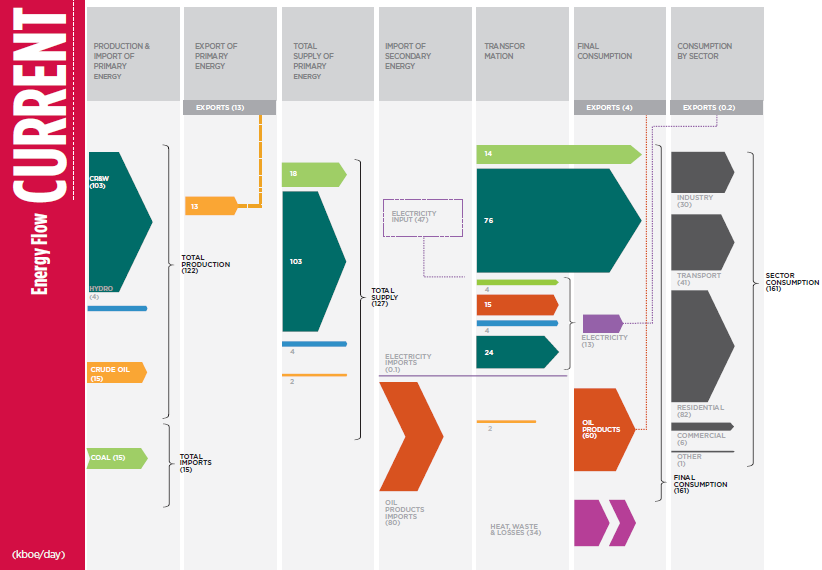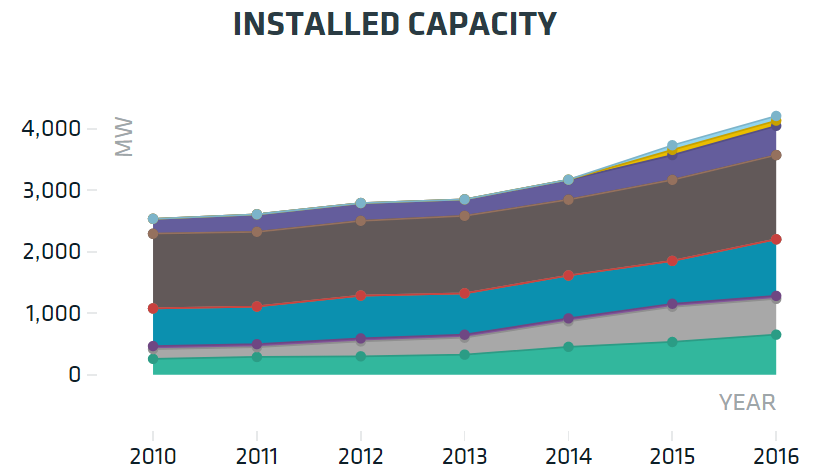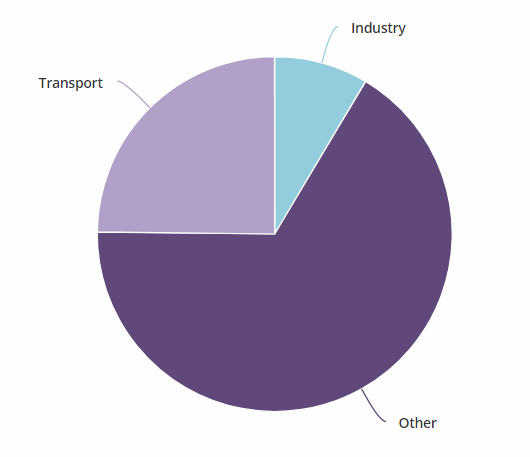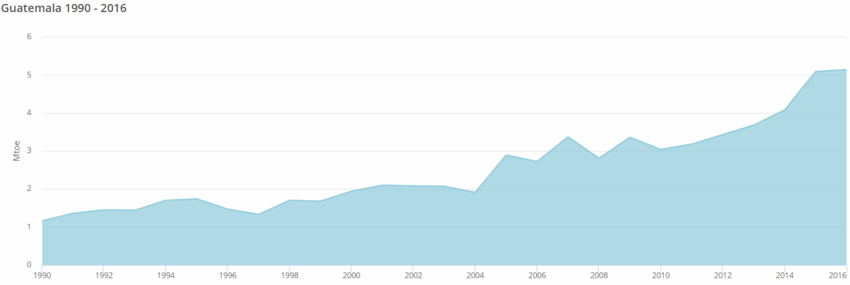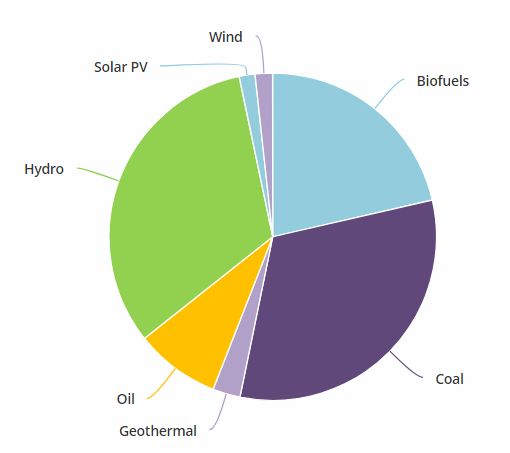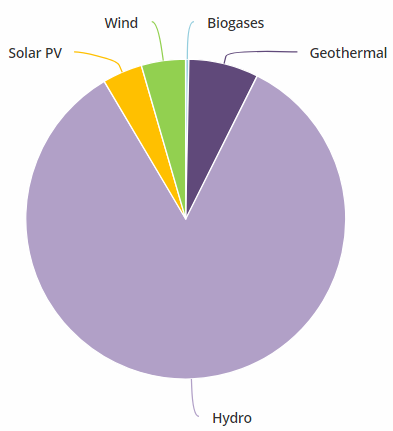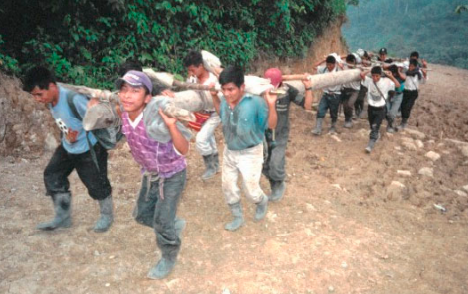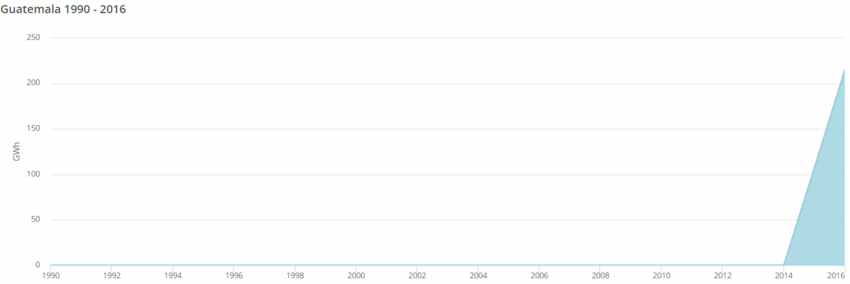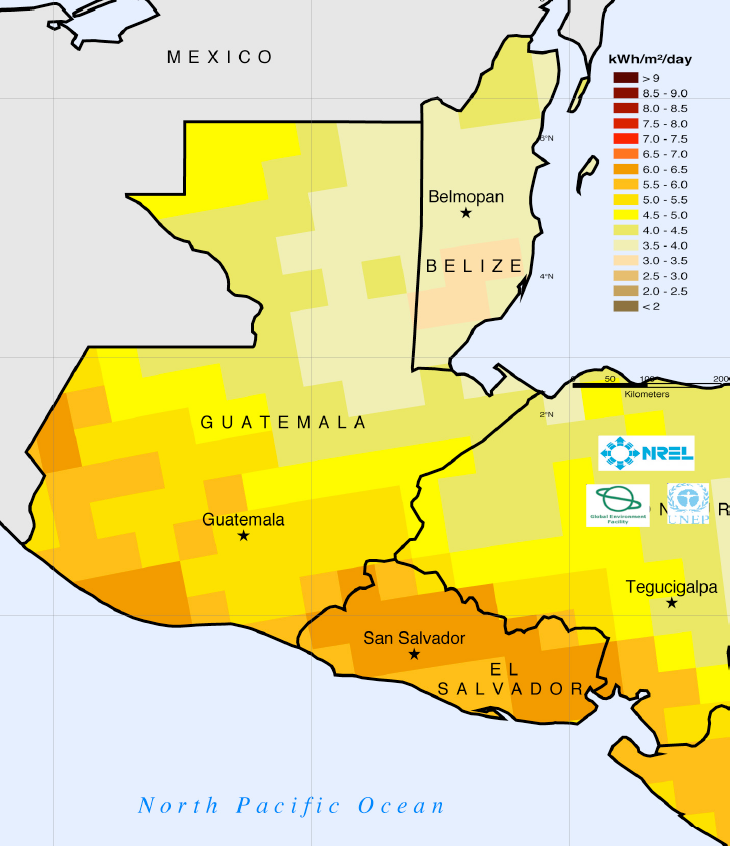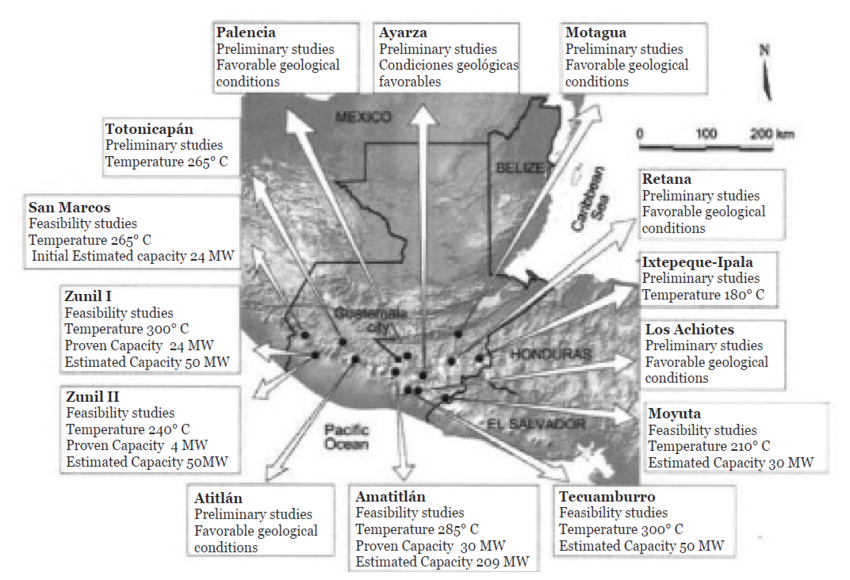Knowledge fuels change - Support energypedia!
For over 10 years, energypedia has been connecting energy experts around the world — helping them share knowledge, learn from each other, and accelerate the global energy transition.
Today, we ask for your support to keep this platform free and accessible to all.
Even a small contribution makes a big difference! If just 10–20% of our 60,000+ monthly visitors donated the equivalent of a cup of coffee — €5 — Energypedia would be fully funded for a whole year.
Is the knowledge you’ve gained through Energypedia this year worth €5 or more?
Your donation keeps the platform running, helps us create new knowledge products, and contributes directly to achieving SDG 7.
Thank you for your support, your donation, big or small, truly matters!
Guatemala Energy Situation
Capital:
Guatemala City
Region:
Coordinates:
14.38°N, 90.30°W
Total Area (km²): It includes a country's total area, including areas under inland bodies of water and some coastal waterways.
XML error: Mismatched tag at line 6.
Population: It is based on the de facto definition of population, which counts all residents regardless of legal status or citizenship--except for refugees not permanently settled in the country of asylum, who are generally considered part of the population of their country of origin.
XML error: Mismatched tag at line 6. ()
Rural Population (% of total population): It refers to people living in rural areas as defined by national statistical offices. It is calculated as the difference between total population and urban population.
XML error: Mismatched tag at line 6. ()
GDP (current US$): It is the sum of gross value added by all resident producers in the economy plus any product taxes and minus any subsidies not included in the value of the products. It is calculated without making deductions for depreciation of fabricated assets or for depletion and degradation of natural resources.
XML error: Mismatched tag at line 6.2 ()
GDP Per Capita (current US$): It is gross domestic product divided by midyear population
XML error: Mismatched tag at line 6. ()
Access to Electricity (% of population): It is the percentage of population with access to electricity.
XML error: Mismatched tag at line 6.no data
Energy Imports Net (% of energy use): It is estimated as energy use less production, both measured in oil equivalents. A negative value indicates that the country is a net exporter. Energy use refers to use of primary energy before transformation to other end-use fuels, which is equal to indigenous production plus imports and stock changes, minus exports and fuels supplied to ships and aircraft engaged in international transport.
XML error: Mismatched tag at line 6.no data
Fossil Fuel Energy Consumption (% of total): It comprises coal, oil, petroleum, and natural gas products.
XML error: Mismatched tag at line 6.no data
Introduction
Guatemala is located in Central America[1]. It shares its borders with Mexico in the north, Belize and Honduras in the east, and El Salavador in the south[1][2]. On the west, the country borders the Pacific, with a much shorter northeastern Caribbean coastline[1][2]. The country's major cities are: Guatemala city -the capital-, Quetzaltenango, Escuintla, Livingston and Puerto Barrios[1].
Guatemala is divided topographily into four general regions: central-western highlands, southern volcanic regions of the Sierra Madre, tropical coastal lowlands, and the low northern plateau, which is mainly jungle[1][2].
Predominantly, Guatemala is an agricultural socitey, where farming is the major economic activiy, with forestry and mining close behind[1]. The best soils suitable for farming are located on the Pacific coastal line, while the soil in the Peten tends to erode quickly, and highland soils are better protected because of coffee cultivation[1].
Guatemalan climate varies with accordance to the altitude of the region, and the proximity to the coasts[1][2]. The tierra caliente (hot country), which extends from the sea level into 750m above sea level, and its temperature is around 29°-32°C[1]. The tierra templada (temperate country) extends from 750-1660m above sea level, with day temperature 24°-26°C, and night temperatures 15.5°-21°C[1].The tierra fria (cold country) extends above 1660m above sea level with an average temperature of 26°C at day, and 10°C at night[1].
The country's main natural resources are predominantly: petroleum, nickel, rare woods, fish, chicle and hydropower, with approximately 41.2% of the land used for agriculture (14.2% arable land - 8.8% permanent crops - 18.2% permanent pasture), while forest represents 33.6% of the land[3].
In terms of energy, Guatemala comes as the second largest Central American power market, with a total generating capacity of 4.2GW[4]. Guatemala total energy generation capacity in 2016 was 10.9TWh, of which 41% came from fossil-based generation, 24% from large hydro, and 35% was from renewables (small hydro, wind, solar, biomass and geothermal)[4].
Energy Situation
Overview
Guatemala shows high dependency on firewood, especially for residential demand[5][6]. Though the country has a high potential of natural resources for energy generation and production, with approximately 34% of forestry richness of the total national territory, yet Guatemala still highly depends on hydrocarbons for supplying industrial and productivity sectors[3][5].
Due to this high dependency on hydrocarbons, Guatemala categorizes as a net energy importer[5]. However, the Guatemalan authorities have planned and implemented significant measures to change the country's energy mix, and promote further energy production sources, including renewables[5].
Though firewood represents the main source of energy for household/residential across the country (app. 63%), yet, biomass has started to gain significant importance to meet the continuously increasing energy demand[5]. Thus being encouraged by the domestic investment by local sugar industry, which has started producing biodiesel and energy from sugar-cane pulp[5].
| Source | Diesel | Gasoline | Fuel Oil | Biodiesel from Sugar Cane Pulp + Propane |
|---|---|---|---|---|
| Percentage | 12% | 8% | 4% | 3% |
Forced by the continued power supply constraints to meet the increasing demand, the Guatemalan government had to issue more power supply contracts with private companies, which allowed the growth of the installed thermal generation capacity[5]. Thus being nearly 400% during the period 1993-2002, with other facilities being built as well to add more generation capacity to the country's scheme during the same period[5]. Two geothermal-powered plants in particular were installed: Calderas (5MW) in 1998, and Zunil (24MW) in 1999[5].
Guatemala has many natural reserves of both oil and gas[5], yet both are under-utilized. There exist approximately 153 oil wells, however only 58 are currently utilized for oil production[5].
The country enjoys a wealth of renewable resources, though they are not yet utilized to their full potential[5]. For example; out of possible 5000MW hydroelectric power potential, Guatemala uses only 853 MW (17.06%), and of 1000MW potential of geothermal energy, the country uses just 49.2MW (4.92%)[5].
| 1971-1974 | 1984-1987 | 1999-2002 | 2005-2008 | |||||||||||
|---|---|---|---|---|---|---|---|---|---|---|---|---|---|---|
| Fuel | Oil Products | Hydro | Bio-Combustibles | Liquid Fuels | Hydro | Bio-Combustibles | Coal | Oil Products | Hydro | Bio-Combustibles | Coal | Oil Products | Hydro | Bio-Combustibles |
| Input Percentage | 80% | 11% | 9% | 54% | 30% | 16% | 10% | 49% | 14% | 27% | 22% | 48% | 25% | 38% |
| General Outlines |
|
|
|
| ||||||||||
Energy Access
| Total Access | Urban | Rural | ||||
|---|---|---|---|---|---|---|
| Year | 2000 | 2010 | 2014 | 2016 | 2016 | 2016 |
| % Population | 73 | 84 | 85 | 92 | 97 | 86 |
| Year | 2000 | 2010 | 2014 | 2016 |
|---|---|---|---|---|
| % Population | 39 | 43 | 45 | 45 |
Production
Guatemalan total energy production reached approximately 9.6Mtoe by the year 2016[8].
Installed Capcity
The total installled power capacity of the country is about 4.21GW with renewables representing approximately 32% share[4].
For more details on the graph Click Here.
Consumption
Import and Export
The most recent Guatemalan imports were led by refined petroleum (~10.8%) of the total imports, while petroleum gas represented approximately 1.4%, and coal briquettes about 0.92%[9].
| Source | Electricity | Crude Oil | Refined Petroleum Products |
|---|---|---|---|
| Exporting Capacity | 1.858 billion kWh | 7,783 bbl/day | 8,178 bbl/day |
Electricity
| Indicator | Production | Consumption | Exports | Imports | Total Installed Capacity |
|---|---|---|---|---|---|
| Capacity | 11.49 billion kWh | 10.02 billion kWh | 1.858 billion kWh | 891.4 million kWh | 4.072 million kW |
| World Ranking | 98 | 95 | 48 | 70 | 86 |
| Source | Fossil Fuels | Nuclear Fuels | Hydroelectric Plants | Renewables |
|---|---|---|---|---|
| % of Total Installed Capacity | 57.9 | 0 | 35.3 | 6.8 |
| World Ranking | 135 | 104 | 61 | 82 |
Energy Security
Since Guatemala is a developing country, that is emerging from a civil war which lasted for 36 years, with more than 50% of its population living in poverty, the country faces several social and economic challenges[10]. These challenges cannot be overcome without the improvement of electricity access for supporting basic services and boosting up labor productivity[10]. In that regard, the Ministry of Energy has proposed an expansion of the electricity generating capacity 2014-2028 to meet the increasing energy demand, while reducing dependency on fossil fuels (e.g. oil products), diversifying the energy mix from fossil fuels to renewables, and reducing electricity costs[10].
On one hand, attempting cost optimization in the energy sector could provide opportunities to improve social capital[10]. On the other hand, increasing energy intensity could make societies highly vulnerable to any supply disruption, which demands better strategies for enhancing security of electricity supply[10]. Within that context, energy security is to be defined with accordance to to the electricity supply, taking into account needs and objectives of the country's energy policy[10]. The key aspects of the energy security perspective in Guatemala are: adequacy, resilience and sovereignty[10].
To achieve energy security in the Guatemalan case, few elements should be considered[10]:
- Securing major national energy services from disruptions.
- In order to properly conceptualize enegy security, it is of an utmost importance to identify threats and vulnerabilities of the energy sysem of the country.
- Limiting dependency on fuel imports.
- Policy makers should prioritize securing where from the country imports its fuels, as if the imports are not from close and trusted countries, the supply system will always be vulnerable.
- To improve the country's poverty situation, energy prices should not be very high.
- Affordability in that context is correlated with prices of energy that are influenced by changes within the energy systems, such as: higher fuel prices due to scarcity or higher demand, not with relation to GDP or income per capita.
With all these factors in consideration, energy security in the case of Guatemala can be defined as follows: "Ensuring the availability of reliable and affordable energy services that are equitably shared, through decreasing dependence on imports, increasing diversity in the system, and increasing reliance on indigenous resources that are environmentally clean to support a sustainable economy able to meet current and future energy demand." [10]
Consequently, this definition reflects both the objects and concerns which are expressed in the Guatemalan energy policy.
Challenges[10]:
- Volatility of energy carriers' prices.
- Demand growth.
- Low electrification rates in rural areas.
Opportunities[10]:
- Availability of natural resources.
- The possibilities of utilizing these resouces to achieve self-sufficiency and sustainability in the electrcity sector.
Renewable Energy
Guatemala aims to achieve 60% of its total electricity generation from renewables by 2020, while on the long term 80% of the total electricity generation[11].
| Year | 2008 | 2009 | 2010 | 2011 | 2012 | 2013 | 2014 | 2015 | 2016 | 2017 |
|---|---|---|---|---|---|---|---|---|---|---|
| Capacity (MW) | 1182 | 1206 | 1311 | 1341 | 1515 | 1646 | 1775 | 2178 | 2667 | 2753 |
Hydropower
According to the International Hydropower Association (IHA)'s 2017 report on global hydropower status, Guatemala ranks 20th worldwide in the new hydropower installed during 2016 with 163MW capacity added that year[13]. Also the country ranks 6th in the Northern and Central America region with total installed power approximately 1154MW[13].
The country has potential for environmentally-friendly hydropower on different scales: household-scale turbines (100s of Watts), community-scale systems (10s of KWatts) and grid-connected-scale (MWs)[14].
| Year | 2008 | 2009 | 2010 | 2011 | 2012 | 2013 | 2014 | 2015 | 2016 | 2017 |
|---|---|---|---|---|---|---|---|---|---|---|
| Capacity (MW) | 776 | 668 | 885 | 902 | 986 | 997 | 1001 | 1087 | 1392 | 1438 |
A micro-hydro project of 165 kW, which is located 300km northwest of Guatemala city, was constructed to serve approximately 2500 individuals of Chel, Xesayi and Las Flores[14]. The project was community-built, with each family contributing 80 days of labor between 2003-2007 in exchange for a connection to the system[14]. The power generated of this project was able to turn Chel into a regional hub, consequently pushing small businesses to flourish, such as: butchers, ice factories, blacksmiths and a library[14].
Wind
Guatemala's Ministry of Energy and Mines (MEM) used to estimate wind energy potential in the country as high as 7000MW, while much more conservative opinions consider the economically viable wind potential in the country is somewhere between 400-700MW[14].
| Year | 2008 | 2009 | 2010 | 2011 | 2012 | 2013 | 2014 | 2015 | 2016 | 2017 |
|---|---|---|---|---|---|---|---|---|---|---|
| Capacity (MW) | 0 | 0 | 0 | 0 | 0 | 0 | 0 | 76 | 76 | 76 |
Solar
According to the solar maps of Solar and Wind Energy Resource Assessment (SWERA), Guatemala's average solar irradiaion is 5.3kWh/m2/day[14].
Few small photovoltaic projects have been implemented in several Guatemalan remote areas, which have no access to grid electricity[14]. Back in 2004, USAID has partnered with Fundación Solar and other local NGOs in order to launch 180 photovoltaic projects in six rural communities in the northern Quiche region of Guatemala for: households, both commerical and community use[14].
| Year | 2008 | 2009 | 2010 | 2011 | 2012 | 2013 | 2014 | 2015 | 2016 | 2017 |
|---|---|---|---|---|---|---|---|---|---|---|
| Capacity (MW) | 0 | 0 | 1 | 1 | 2 | 3 | 10 | 93 | 93 | 99 |
Bioenergy
Guatemala has a powerful agro-industrial sector with considerable biomass waste products, hence there is a large potential for generating electricity from agricultural biomass in the country[14]. Guatemalan sugar mills already use their produced waste of biomass to generate electricity in the country[14].
During the country's harvest season, which is from November-May, these mills have the ability to generate about 25% of Guatemala's electricity[14]. Thus by burning sugarcane bagasse along with other residues[14].
| Year | 2008 | 2009 | 2010 | 2011 | 2012 | 2013 | 2014 | 2015 | 2016 | 2017 |
|---|---|---|---|---|---|---|---|---|---|---|
| Capacity (MW) | 351 | 373 | 372 | 384 |
473 |
598 |
714 |
873 |
1056 | 1091 |
For firewood, though it is widely used in the country, its energy is inefficiently exploited across rural areas[5]. This is because an estimation of approximately 81% of the households, which use this form of energy, are found to use it in a type of stoves called "three stones stoves", which wastes about 90% of the produced energy[5].
Geothermal
During the 70s, several international agencies (JICA, IDB, OPEC, ROCAP/USAID, IAEA & OLADE) cooperated with INDE for identifying Guatemala's geothermal resources[15]. In conclusion, it was found that the country has more than 12 geothermal important resrevoirs[15].
Approximate estimates show that the country has a geothermal potential power in the range 400-4000MW, and some literature assume it is 800-4000MW[14][15]. Yet, Guatemala's Ministry of Energy and Mines claims that the economically viable potential does not exceed 1000MW[14].
The interest to invest in Guatemala's geothermal potential is on the rise, with 2 geothermal plants are currently operating in the country -and they represent its main geothermal operating resources-: Zunil (24MW capacity) & Ortitlán (25MW capacity)[14][15].
| Year | 2008 | 2009 | 2010 | 2011 | 2012 | 2013 | 2014 | 2015 | 2016 | 2017 |
|---|---|---|---|---|---|---|---|---|---|---|
| Capacity (MW) | 54 | 54 | 54 | 54 | 54 | 49 | 49 |
49 |
49 |
49 |
The main barriers for developing geothermal resources in Guatemala[15]:
- Economic constraints.
- High risk in early stages (exploratory stages).
- Competition with the possibility of developing cheaper energy sources, such as: hydropower & natural gas.
The Guatemalan government has a plan of using geothermal power to supply for two thirds of the country’s energy needs by 2022[16]. Thus reducing oil imports and stabilizing the country’s energy supply[16].
Fossil Fuels
Crude Oil & Refined Petroleum Products
| Indicator | Production | Exports | Imports | Proved Reserves |
|---|---|---|---|---|
| Capacity | 9641 bbl/day | 7873 bbl/day | ||
| World Ranking | 80 |
Crude oil production in Guatemala has high potential, with estimations suggesting the possibility of reaching 50000 barrels/day[17]. Main Guatemalan products in that regard are: 'heavy crude oil' with API gravities 10-22.3 & 'bitter' with Sulphur percentages > 1%[17].
Coal
Key Problems of the Energy Sector
Policy Framework, Laws and Regulations
Institutional Set up in the Energy Sector
Other Key Actors / Activities of Donors, Implementing Agencies, Civil Society Organisations
Further Information
- Tracking SDG7 in Guatemala 2018
- Guatemala's Energy Access from the World Bank Data
- Guatemala's Total Imports & Exports
- Energy Security and Sustainable Development Implications for Guatemala of the Electricity Generation Expansion Plan 2014-2028
References
- ↑ 1.00 1.01 1.02 1.03 1.04 1.05 1.06 1.07 1.08 1.09 1.10 https://info.publicintelligence.net/MCIA-GuatemalaHandbook.pdf
- ↑ 2.0 2.1 2.2 2.3 https://eneken.ieej.or.jp/data/4474.pdf
- ↑ 3.0 3.1 3.2 3.3 3.4 https://www.cia.gov/library/publications/the-world-factbook/geos/gt.html
- ↑ 4.0 4.1 4.2 http://global-climatescope.org/en/country/guatemala/#/enabling-framework
- ↑ 5.00 5.01 5.02 5.03 5.04 5.05 5.06 5.07 5.08 5.09 5.10 5.11 5.12 5.13 5.14 5.15 British Embassy Guatemala City. (2013). Guatemala: Energy Sector Opportunities for UK Companies. Retrieved From: https://assets.publishing.service.gov.uk/government/uploads/system/uploads/attachment_data/file/200567/GUATEMALA_-_Energy_Sector_Report_2013.pdf
- ↑ 6.0 6.1 Espinasa, R. Balza, L. Hinestrosa, C. and Sucre, C. (2013). Energy Dossier: Guatemala. Retrieve From: https://publications.iadb.org/bitstream/handle/11319/3856/Dossier%2005%20Guatemala%20Eng.pdf?sequence=6&isAllowed=y
- ↑ 7.0 7.1 Tracking SDG7. (2018). The Energy Progress Report. Retrieved From: https://trackingsdg7.esmap.org/data/files/download-documents/tracking_sdg7 the_energy_progress_report_full_report.pdf
- ↑ International Energy Agency (IEA). (2018). Key World Energy Statistics – A Wealth of Energy Stats at your Fingertips. Retrieved From: https://webstore.iea.org/download/direct/2291?fileName=Key_World_2018.pdf
- ↑ https://atlas.media.mit.edu/en/profile/country/gtm/
- ↑ 10.00 10.01 10.02 10.03 10.04 10.05 10.06 10.07 10.08 10.09 10.10 Ochaeta, K. (2014). Energy Security and Sustainable Development Implications for Guatemala of the Electricity Generation Expansion Plan 2014-2028. Master thesis in Sustainable Development at Uppsala University. Retrieved From: http://uu.diva-portal.org/smash/get/diva2:749642/FULLTEXT01.pdf
- ↑ Cabré, M. M. López-Peña, A. Kieffer, G. Ferroukhi, R. Khaled, A. & Hawila, D. (2015). Renewable Energy in Latin America 2015: An Overview of Policies. Retrieved From: http://www.irena.org/documentdownloads/publications/irena_re_latin_america_policies_2015.pdf
- ↑ 12.0 12.1 12.2 12.3 12.4 12.5 Whiteman, A. Sohn, J. Arkhipova, I. & Elsayed, S. (2018). Renewable Capacity Statistics 2018. Retrieved From: https://www.irena.org/-/media/Files/IRENA/Agency/Publication/2018/Mar/IRENA_RE_Capacity_Statistics_2018.pdf
- ↑ 13.0 13.1 International Hydropower Association (IHA). (2017). The 2017 Hydropower Status Report: an Insight into Recent Hydropower Development and Sector Trends around the World. Retrieved From: https://www.hydroworld.com/content/dam/hydroworld/online-articles/2017/08/2017%20Hydropower%20Status%20Report-1.pdf
- ↑ 14.00 14.01 14.02 14.03 14.04 14.05 14.06 14.07 14.08 14.09 14.10 14.11 14.12 14.13 14.14 Koberle, A. (2012). An Alternative Power Development Plan for Guatemala. Retrieved From: https://www.internationalrivers.org/sites/default/files/attached-files/energia_ingles_072412.pdf
- ↑ 15.0 15.1 15.2 15.3 15.4 Urízar, C. (2012). Reactivating Guatemala’s Geothermal Industry: A Preliminary Approach. Retrieved From: https://www.mofa.go.jp/region/latin/fealac/pdfs/2-3_guatemala.pdf
- ↑ 16.0 16.1 Glenn, J. & Matek, B. (2014). The Status of Geothermal Power in Emerging Economies. Retrieved From: http://geo-energy.org/events/Emerging%20Economies%20Market%20Update%20draft_final_Oct%2016th_final.pdf
- ↑ 17.0 17.1 Ávalos, C. (2014). Invest in Guatemala: Energy and Oil – Industry in Guatemala. Retrieved From: http://www.investinguatemala.org/sites/default/files/2-energy-oil_eng.pdf


